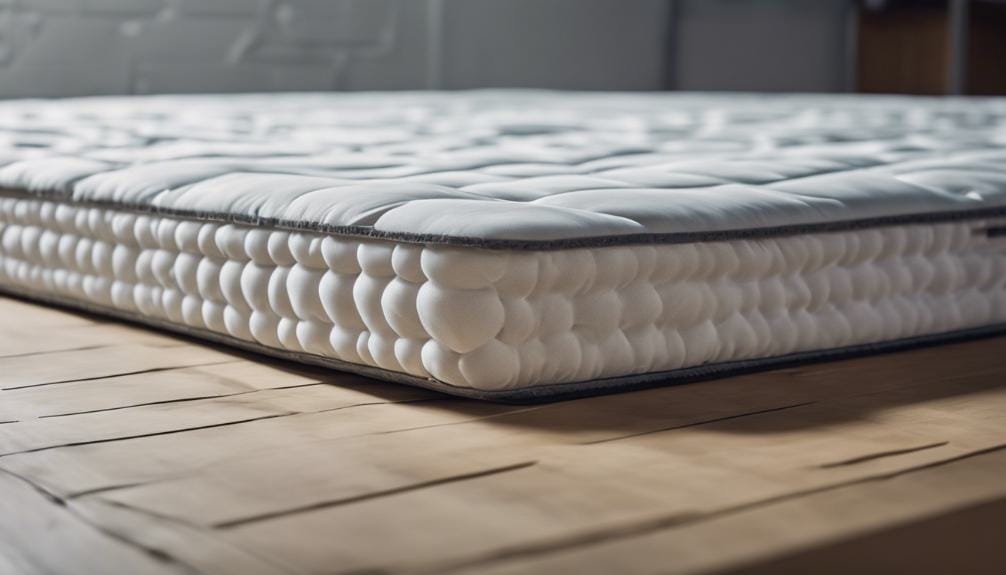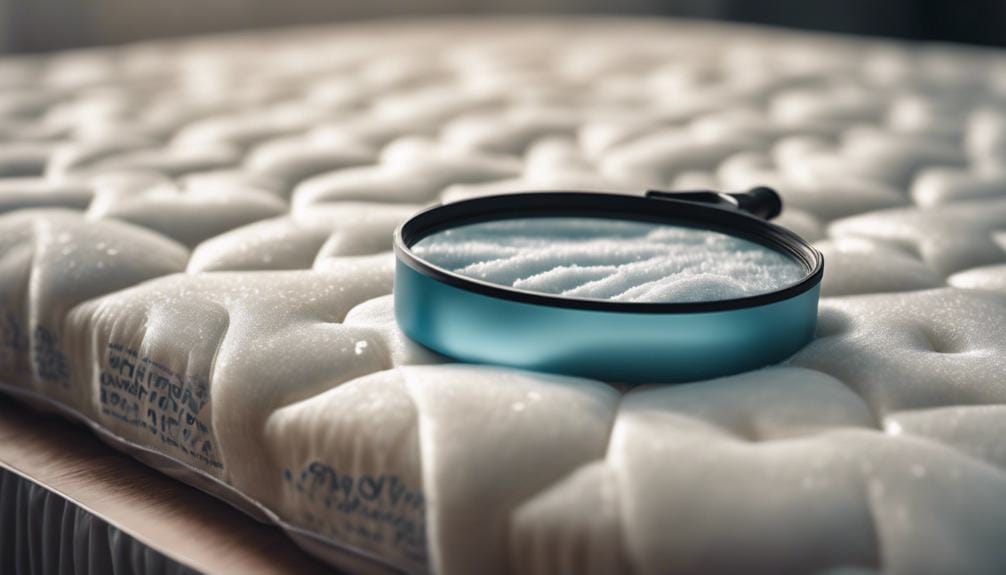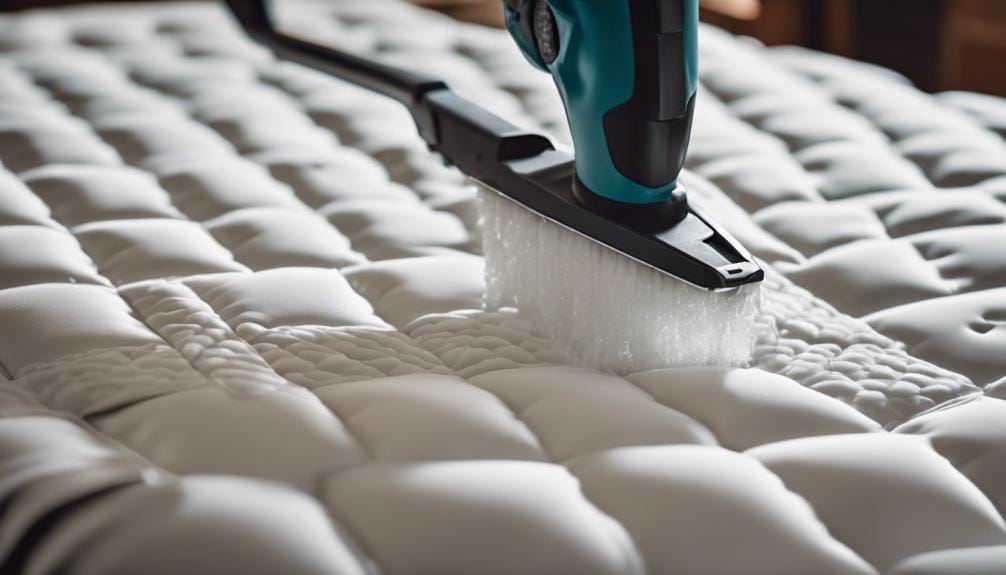Do Mattress Toppers Have Fiberglass? Exploring Composition and Safety
Ever wondered if your cozy mattress topper hides a surprising secret? That’s right, fiberglass might be lurking beneath the surface, safeguarding you from potential fire hazards.
However, before you start contemplating a mattress overhaul, it’s crucial to understand the implications of fiberglass in your topper. While safety is paramount, the composition of these bedding essentials could pose unforeseen risks.
Stay tuned to unravel the mysteries of mattress toppers – your sleep sanctuary might not be as innocent as it seems.
Key Takeaways
- Fiberglass in mattress toppers acts as a safety barrier against fires.
- Mattress toppers typically contain layers including fiberglass for fire protection.
- Consumers should be aware of safety concerns related to fiberglass exposure.
- Regular inspection and precautions can help ensure safe use of mattress toppers.
Understanding Fiberglass in Mattress Toppers
Understanding the role of fiberglass in mattress toppers is essential for grasping the crucial safety features these products offer. Fiberglass, a material known for its fire protection properties, is commonly used as a safety barrier in mattress toppers. Positioned beneath the fabric cover, the fiberglass layer acts as an insulation barrier to prevent mattresses from catching fire and to contain any potential fires that start on the exterior. Manufacturers often provide information on the presence of fiberglass in mattress toppers as it’s a vital component for fire-proofing these products.
The inclusion of fiberglass in mattress toppers isn’t only a regulatory requirement but also a safety necessity. By creating a protective barrier, fiberglass enhances the fire resistance of mattress toppers, reducing the risk of fire-related incidents in the bedroom. This insulation material plays a pivotal role in ensuring that mattresses meet safety standards and provide consumers with peace of mind regarding fire safety in their homes.
Examining Mattress Topper Composition

Examining the composition of mattress toppers reveals the intricate layers of materials that contribute to their comfort and functionality. Mattress toppers typically consist of multiple layers, each serving a specific purpose. One crucial component found in many mattress toppers is fiberglass, which acts as a fire-protectant barrier underneath the fabric. This fiberglass layer plays a vital role in preventing fires by providing insulation and meeting necessary safety standards for flammability.
Here is a breakdown of the typical composition of mattress toppers:
| Layer | Material | Function |
|---|---|---|
| Top Fabric | Cotton/Polyester | Provides comfort and softness |
| Middle Layer | Memory Foam | Offers support and pressure relief |
| Bottom Layer | Fiberglass | Acts as a fire barrier and provides insulation |
Manufacturers often provide information regarding the materials used in their mattress toppers, including the presence of fiberglass. This transparency allows consumers to make informed decisions based on their preferences and safety considerations. While fiberglass may raise concerns for some individuals due to potential safety hazards, it is essential for ensuring that mattress toppers comply with necessary fire safety regulations. By understanding the composition of mattress toppers, you can make educated choices when selecting a product that aligns with your comfort and safety needs.
Safety Concerns With Fiberglass in Toppers

While fiberglass in mattress toppers enhances safety by acting as a fire-protectant barrier, it also raises valid concerns regarding potential safety hazards. The presence of fiberglass serves as a crucial component for fire protection, as it effectively prevents mattresses from catching fire and helps contain fires starting on the mattress’s exterior. This insulation property of fiberglass significantly contributes to improving overall fire safety standards in mattresses.
However, despite its fire-retardant qualities, the use of fiberglass in mattress toppers raises safety concerns due to its potential flammability and the risk of fiberglass particles becoming airborne. If the fiberglass barrier is damaged, it can release small glass fibers into the air, posing health risks if inhaled or coming into contact with skin.
To address these concerns, it’s essential for manufacturers to provide clear information about the presence of fiberglass in mattress labels. Consumers should also consider checking the origin of the mattress, as this can provide insights into the composition of the topper. By being informed about the materials used in mattress construction, individuals can make better decisions regarding their safety and well-being when it comes to fiberglass in mattress toppers.
Identifying Fiberglass in Mattress Toppers

To identify fiberglass in mattress toppers, examine the layer positioned beneath the fabric for a fire-protectant barrier. Fiberglass in mattress toppers serves the crucial function of preventing mattresses from catching fire. This fiberglass layer, typically located just beneath the top fabric, acts as a fire-protectant barrier.
When seeking to identify fiberglass in mattress toppers, one method is to check for manufacturer information. Manufacturers often provide details about the composition of their products, including the presence of fiberglass for fire safety.
When inspecting a mattress topper for fiberglass, start by looking at the fabric layer and then proceed to check for any additional layers underneath. Since fiberglass is primarily used as a fire-retardant material, it’s likely to be situated close to the top surface.
Mattress labels can also offer valuable insights into the materials used in the topper’s construction, including the presence of fiberglass. If there are concerns about fiberglass exposure, checking these labels can provide clarity on whether fiberglass is present in the topper’s composition.
Ensuring Mattress Topper Safety

To ensure the safety of your mattress topper, it’s crucial to understand the role of fiberglass as a fire-protectant barrier and take necessary precautions for safe usage. Fiberglass in mattress toppers is primarily present to prevent mattresses from catching fire and provide insulation. Here are five key steps to ensure the safety of your mattress topper:
- Check the Mattress Label: Look for information provided by manufacturers regarding the presence of fiberglass in the mattress topper.
- Inspect for Damage: Regularly check your mattress topper for any signs of wear or damage that could release fiberglass particles.
- Use a Mattress Protector: Consider using a mattress protector to create an additional barrier between the fiberglass and your skin.
- Avoid Direct Contact: Minimize direct contact with the fiberglass layer by adding an extra sheet or cover over the mattress topper.
- Consult a Professional: If you experience any skin irritation or breathing issues, seek advice from a healthcare professional to address potential health risks associated with fiberglass exposure.
Frequently Asked Questions
Do Mattress Toppers Have Fiberglass in Them?
Yes, mattress toppers commonly include fiberglass as a fire-protectant barrier positioned beneath the fabric layer. This fiberglass layer acts as insulation to prevent fires, enhancing overall safety. Manufacturers often provide details on the presence of fiberglass in mattress toppers for transparency.
Is Fiberglass in Polyurethane Foam?
Fiberglass is not typically found in polyurethane foam used in mattress toppers. It is more common in fire-resistant layers beneath the fabric. Polyurethane foam, known for comfort and support, can be fiberglass-free for safe sleep.
Does Memory Foam Contain Fiberglass?
When it comes to memory foam mattress toppers, fiberglass isn’t typically part of the equation. Manufacturers prioritize comfortable materials like foam layers and fabrics. You can rest easy knowing you’re choosing a safe option for your sleep surface.
What Are Mattress Toppers Made From?
Mattress toppers are commonly crafted from memory foam, latex, feathers, or fiberfill. These materials cater to various comfort and support preferences. Some toppers may include fiberglass as a fire barrier, enhancing safety and durability.
Conclusion
In conclusion, it’s crucial to be aware of the presence of fiberglass in mattress toppers and the potential health risks associated with exposure to fiberglass fibers.
By understanding the composition of mattress toppers and identifying any fiberglass components, individuals can take steps to ensure their safety and consider alternative options if necessary.
Prioritizing mattress topper safety is key to maintaining a healthy sleep environment and minimizing any potential health concerns related to fiberglass exposure.
